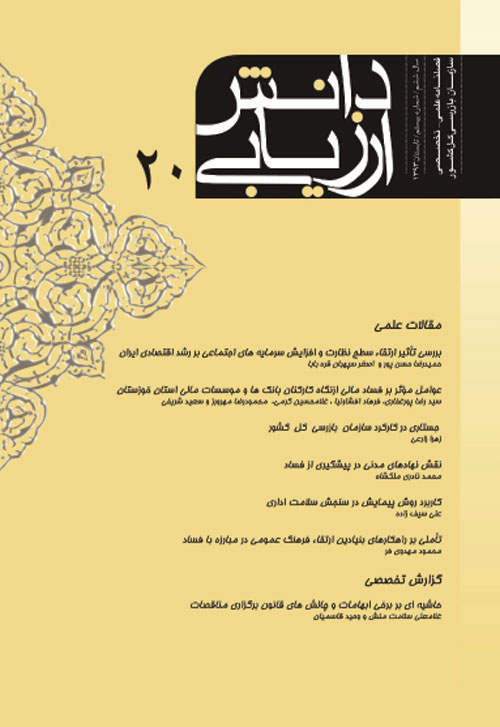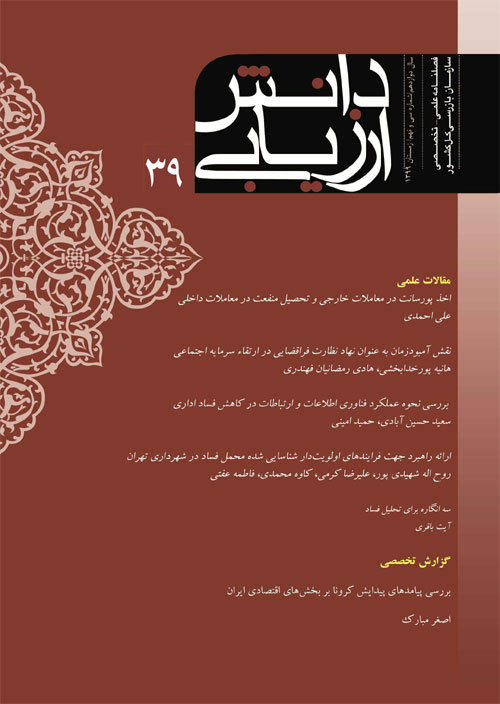فهرست مطالب

فصلنامه دانش ارزیابی
پیاپی 20 (تابستان 1393)
- بهای روی جلد: 30,000ريال
- تاریخ انتشار: 1393/06/20
- تعداد عناوین: 8
-
صفحه 3
- مقالات علمی
- گزارش تخصصی
-
Page 5Nowadays, social capital along with human capital and physical capital are among the explaining concepts of Growth. Mutual confidence between individuals and economic units are a part of social capital. Confidence which means the believe in other people in doing their obligations in socio-economic interactions is the main factor in generating social capital. In fact, such a belief makes the interchanges and interactions easier. In this research, the model of endogenous growth and also variables such as social, human and physical capital are used to investigate their total effects on the variable of Economic growth in Iran Furthermore, the variable of social capital with two indexes of level of total participation (the ratio of number of members in cultural, artistic and political centers to population) and the level of crime (the ratio of number of judicial cases to population) are used.The tools of estimation of model are techniques of time series in advanced econometrics. For this purpose, long- run co integrating method of Johansen – Juselius is used and for analysis of short – run relations of variables, the method of Error correction vector (ECM)is used. The finding of this estimation shows that in long - run two co integrating vectors shall be attained and both of them indicate this fact that in long – run social capital along with human and physical capital have the positive effects on the Economic growth in Iran. Furthermore, both of these vectors show that in long – run social capital has the highest effect on the Economic growth in Iran. In short – run, also, the relation between accumulation of socials and physical capital with the economic growth in Iran is positive; on the contrary, the relation between human capital and the economic growth is negative. The effect variable of social capital accumulation in short – run is more obvious than the effect of physical capital variable.It is suggested that in order to create economic growth in the country, the government should provide necessary measures regarding cultural preparation for formation of social capital of the society.Keywords: social capital, Human capital, Physical capital, Economic growth, co integration, Iran
-
Page 33This research was carried out in a surveying method aiming at recognizing the effective factors on financial corruption among staffs of banks and financial establishments in khuzestan province. The research statistical society included 15000 staffs of financial establishments and 384 of them were experts selected through a random sampling proper to the volume and they were selected as the sample volume through Cocran sampling formula. In the first phase, the data gathering tool was interviewing chief managers and in the second phase, it was a questionnaire. The reliability of the research tool was approved by the experts and its validity was estimated through Kronbach›s alpha coefficient and Gotman 0.87 and 0.86, respectively. The PCA results through factors exploitation criterion with the special value of more than one showed that the exploited factors of the intended interviews have been put at least on a special-valued factor more than one time and the exploited factors describe 47.674 of data variance totally. The results of analyzing the discovered factor revealed that the effective factors on the financial corruption can be classified into two groups (organizational factors with 31 factors and cultural-social one with 17 factors).Increased inclination toward hiding bureaucratic crimes, paying no attention to rotating financial staffs in time and taking time in investigating process of the crime among high level of administrative dimensions allocate the factor load to themselves. Individualism growth in the society, high level of expectations in the families, low social expenses for corruption and the lack of informing the public regarding different kinds of crimes and their punishments have also allocated the higher factor load in the cultural and social dimensions to themselves. According to the achieved results (KMO=0.776) and considering 0.60 criterion, KMO statistical criterion had an acceptable amount.Keywords: Corruption, financial corruption, cultural, organizational factor, cultural factors
-
Page 49Since corruption and financial mismanagement and ill-function of administrative apparatus play an important role in creating discontent among the people and undermine the foundations of any society, the best way to combat lawlessness and abuse in the administration of the country and the most effective measures for the prevention of the occurrence of defective administration is an ongoing monitoring and oversight of specific institutions in the country. In this regard and due to article 174 of the constitution the GIO supervises and verifies the implementation of laws by the administrative organs responsible. The aim of this study is to identify the nature of an anti-corruption and protector body of the rights of citizens. This research seeks to reflect the structure and functions of the GIO and it’s Structural and functional features.Keywords: General inspection, supervision, administration of justice, civil rights
-
Page 67Corruption is not a new phenomenon, its creation and development have an antiquity as human societies and date of organizations and institutions as a whole, all of the administrative communities have corruption layers and levels. It may be said that in the history of human life,an era cannot be found without corruption. So corruption is an universal and epidemic phenomenon. Now a days,No country knows its administrative systems as perfect and without corruption, it means that all the administrative systems of the world have some degrees of corruption.Policies like free access to information, public teaching and promoting knowledge level, media equipment of civil structures and reporting and protection of corruption informer are among the means for preventing corruption. It can be claimed that the civil institutions struggle for accompanying civil society and its active members with method of confronting with corruption and reporting policy and protect of corruption informer to encourage people for cooperating with institution to confronting with corruption. This study discusses equipment’s and methods of preventing corruption with emphasis on civil structures.Keywords: corruption, civil institution, public teaching access to information, inspection, control
-
Page 85Measuring the concepts of social sciences is regarded as a difficult task needing expertise technical methods. But this difficulty dublicates when corruption becomes the case. It is obvious that such cases need specific methods which are called in our study, methods in administrative integrity. The main objective of this study is investigating the application of survey method in administrative integrity in Iran.Keywords: administrative integrity, the survey method
-
Page 109Fighting corruption requires various approaches at different levels of society. one of the main approaches in this regard is promotion of public culture. The role and impact of public culture on the decline and prevention of corruption necessitate the recognition and assessment of ways to strengthen and promote the public culture. This paper outlines three main approaches within this framework: education, media and non- governmental organizations (NGOs). The first part lays emphasis on education at schools and in universities, where the next generation of managers and employees raise.In The role of media addressed in the next section of the paper. The media’s role is not only to inform the public about facts, but also to warn and educate the public about the harm of corruption and how it undermines the moral standards of society, endangers democracy, deprives citizens of their rights and blocks development. Finally an important way to create public support for anti-corruption programs is strengthening the NGOs. This is an important factor in promoting public awareness about corruption and the need to control it.Keywords: corruption, public culture, media, non, governmental organizations (NGOs)
-
Page 129The law of performing the tenders and its executive regulations is a new law that organized the transactions of the state organizations. In the beginning of enforcing the law, the state organizations confronted many ambiguities and questions that most of them were answered after the approval of its executive regulations, but as the weaknesses and ambiguities reveal during the time, revision of the law becomes necessary. The aim of this article is to identify the challenges and ambiguities of the rule of performing the tenders and its executive regulations from the legal, executive and supervisory aspects and to give the suitable suggestions for a substitute text. The authors hope that the given suggestions will be according to the general legal principles and the spirit of the law of performing the tenders and be applicable.Keywords: tender, bid, rule of performing the tenders, state transactions


